CALIFORNIA NATIVE PLANT SOCIETY
Channel Islands Chapter
Channel Islands Chapter
Rare Plant Profiles:  Navarretia ojaiensis
Navarretia ojaiensis
 Navarretia ojaiensis
Navarretia ojaiensis
Western Transverse Ranges Endemic Species
Leigh Johnson, a plant taxonomist at Brigham Young University, described a new species of Navarretia endemic to Ventura County and southwestern Los Angeles County. The new species is Navarretia ojaiensis, named for Ojai, where most known populations occur. Navarretia ojaiensis is a member of the N. pubescens complex in the Phlox (Polemoniaceae) family.
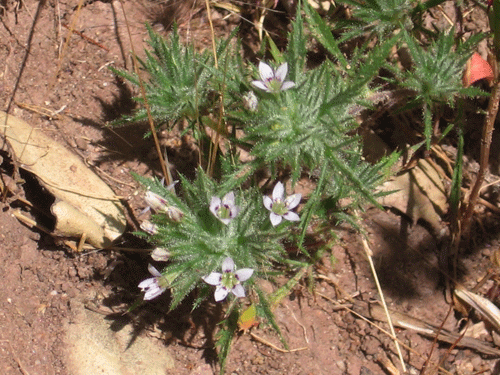
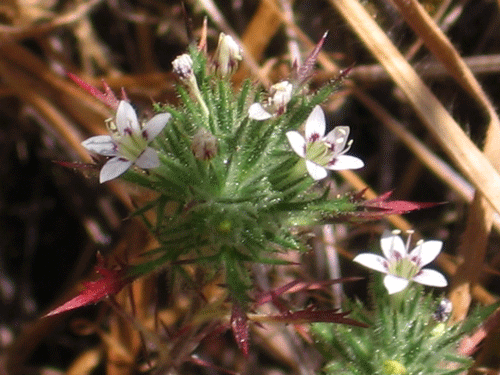
To date (19 June 2011), only 29 specific occurrences are known, comprising 16 populations. However, at least 3 of these have been extirpated by development. The documented population in the Ventura County portion of the Santa Monica Mountains was extirpated to make way for a large garage/studio that is part of a new house for Marco Beltrami, as permitted by the County of Ventura. That small population was located in the area that now contains the parking area for the garage/studio, and has not been observed onsite since 2006. Based on communication with the Ventura County Planning Division, attempts to mitigate for this plant onsite have not been successful. A recently discovered large population in Agoura Hills is threatened by urban development by development of a parking lot to serve employees of the Conrad N. Hilton Foundation at its future facilities, which the City of Agoura Hills permitted in April 2011, which will impact a significant portion of the population onsite.
The Type specimen was collected by Henry M. Pollard in 1948 in a meadow between the California Preparatory School (where Pollard taught) and Ojai. The school buildings are gone now, and the meadow has mostly been developed into houses as part of the Del Oro Tract. Pollard also collected it along the Foothill Trail near the base of Nordhoff Ridge, above Ojai, about ½ mile west of Gridley Road. However, this is on private property and that portion of the trail has been fenced off on the east end, even though the property is not developed at all, or even developable.
Without the benefit of the new key for this species, published in Novon in 2007, using exiting identification keys, it will key out to Navarretia jaredii, a species that is no longer considered valid, according to Johnson.
Navarretia ojaiensis typically occurs on clayey soils, usually in grassland/forbland on north-facing slopes at the base of the slope. It does not appear to compete well with the invasive Mediterranean grasses, such as Bromus diandrus and B. hordeaceus, as those grassland areas where these species are thick, no Navarretia ojaiensis can be found. It blooms from late May to July. Johnson's description is based on the specimens collected from the Ojai Valley. He did not see any specimens from the Santa Monica Mountains, where some populations have blue flowers. Johnson believes that these blue-flowered plants may actually represent another, yet undescribed, species of Navarretia. There is a population near Nicholas Flat off Decker School Road in the Los Angeles County portion of the Santa Monica Mountains that contains both white- and blue-flowered plants, as shown below.
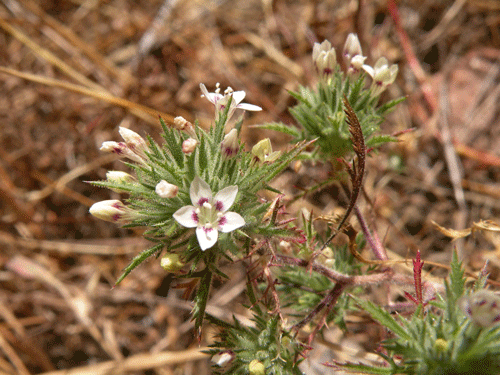
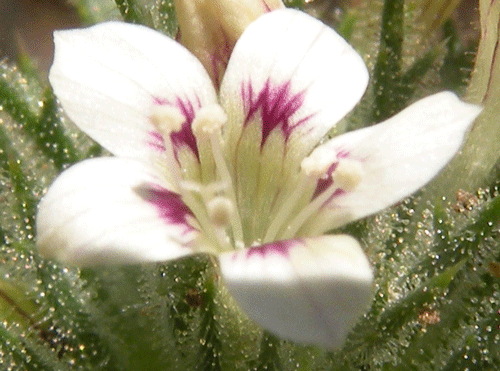
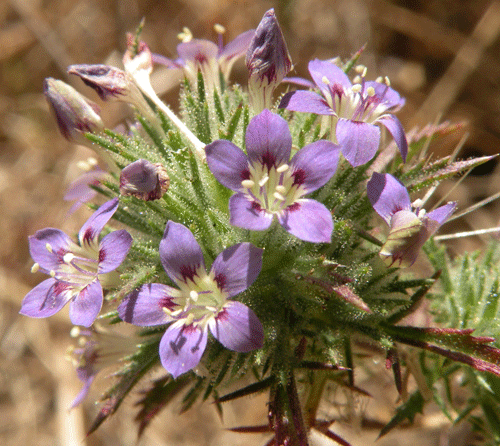
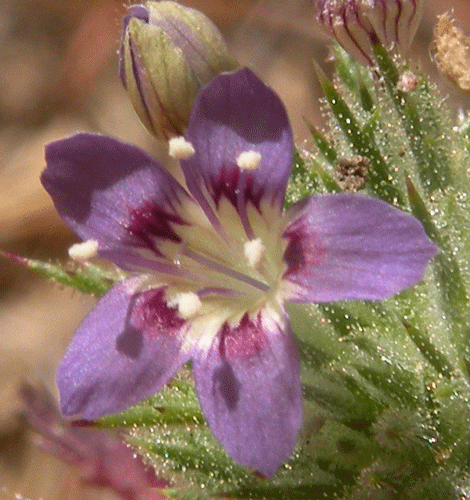
Historic populations in Ojai have apparently been extirpated by development or incompatible land uses/management practices. It can be found along the western and eastern parts of the Foothill Trail. One group of subpopulations occurs on the western part of the trail, first spotted by Marilyn Whitford, including in a meadow at its junction with the Cozy Dell Trail. It also occurs not far east of the Pratt Trail. The Foothill Trail is aligned east and west on the south slope of Nordhoff Ridge above Ojai. It also grows on Villanova Preparatory School's property near Camp Comfort, on the Milner Estate along Creek Road, and on a ridge east of Casitas Dam in the Ojai Valley. Populations outside the Ojai Valley include a couple on Newhall Ranch (Santa Clara River Valley and Santa Susana Mountains), one on Sulphur Mountain south of Ojai, and one (formerly) on the edge of Deals Flat on Marco Beltrami's property, and in Agoura Hills off Kanan-Dune Road, the later two in the Santa Monica Mountains. A population with two subpopulations has been found along Upper Malibu Springs Trail north of Nicholas Flat by Tarja Sagar in the Los Angeles County portion of the Santa Monica Mountains, containing both the blue and the white flowered forms.
Since Navarretia ojaiensis is so rare, the California Native Plant Society has added this new species to its List 1B.1, Plants Rare and Endangered in California and Elsewhere. It also qualifies to be formally listed as Endangered under both the federal Endangered Species Act and the California Endangered Species Act.
Click here for a general map of known occurrences of Navarretia ojaiensis or here for a more detailed map. Look for this new species in late spring and early summer in dry open habitats in clayey soils within southern Ventura County. It may also occur in the Santa Clarita area, Santa Susana Mountains, and Santa Monica Mountains of Los Angeles County.
Here is a link to a page featuring two short video clips showing one of the Foothill Trail occurrences (a ParaType) for Navarretia ojaiensis, Video clips page, both taken on 28 June 2008.
Written by: David L. Magney
Date: Created 3 September 2008, updated 19 June 2011
CHANNEL ISLANDS CHAPTER, CALIFORNIA NATIVE PLANT SOCIETY, PO Box 6, Ojai, CA 93024-0006
Special thanks to Carlin Moyer for the beautiful illustrations on our site. Photos by David Magney.
Last updated: 19 June 2011
For website comments: webmaster(at)cnpsci(dot)org
For website comments: webmaster(at)cnpsci(dot)org